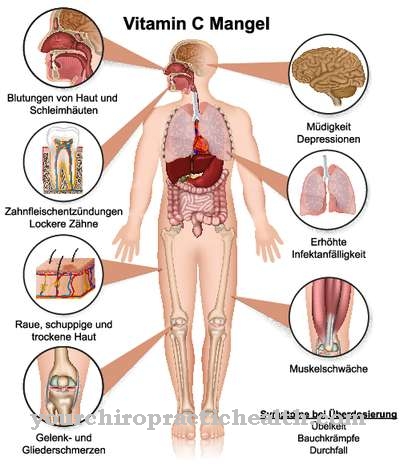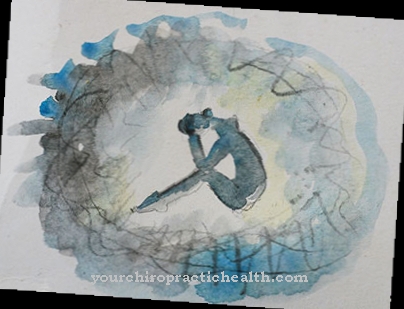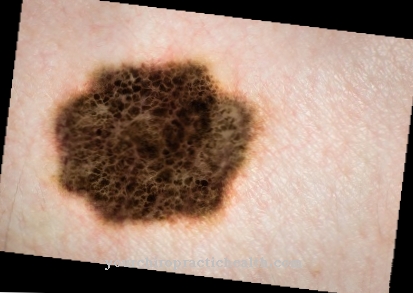Under the medical term Rosacea, or also Rosacea, of course, translated into German, the clinical picture of the so-called Copper fin. In general, more women than men are affected, as well as older people instead of younger ones.
What is rosacea (rosacea)?
.jpg)
© Alessandro Grandini - stock.adobe.com
Rosacea, in English "copper fin", is a skin disease in the face, which is often associated with reddening, pustules and pus vesicles at an advanced age (often from the age of 40/50). These can be triggered, among other things, by food, cosmetics, stress and environmental influences and treated with certain behaviors, creams and tablets.
The first signs include slight reddening of the face, especially around the forehead, cheeks, nostrils and chin. It is characteristic of this disease that both halves of the face are often affected, often even symmetrically.
causes
The causes of the Rosacea are not yet clearly clarified. Scientists suspect, on the one hand, that a regulatory disturbance in the skin circulation in the facial area and, on the other hand, consumer goods such as coffee, tea, spicy dishes or alcohol could be the trigger.
There are also factors such as strong temperature fluctuations, cosmetics, or stress. The cosmetic products are especially those that contain alcohol, menthol, oils and perfume. This could be a possible reason why women in particular are more likely to be affected by rosacea than men.
According to statistics, they often suffer from stress and try to treat small impurities with creams and various other cosmetic products. It should also be mentioned that rosacea is not a hereditary disease and cannot be transmitted.
Symptoms, ailments & signs
Depending on the severity, different forms and different stages of development of rosacea are distinguished. At first, the disease almost always occurs only on the face and here in particular on the nose and forehead as well as on the cheeks and chin. The area immediately around the eyes and mouth is usually left out.
The neck and décolleté are only affected later. Reddening of the skin and dilated blood vessels are characteristic of early rosacea. Patients experience burning or stabbing pain and sometimes severe itching. In the early stages, these symptoms subside after a few days, but the symptoms return.
If the disease progresses, papulopustular rosacea usually forms in the next stage. The reddening slowly begins to turn blue; in addition, vasodilatation, nodules and, in many patients, pus pimples form. At this stage, the disease is often mistaken for acne, which it closely resembles in appearance.
The affected areas of the skin are becoming increasingly sensitive and are allergic to care products and cosmetics. If rosacea hypertrophica occurs, nodular swellings form, especially on the nose. In addition to the physical ailments, it is not uncommon for psychological problems to arise, as the disease has a very disfiguring effect and thus severely affects the general well-being of those affected.
Course of disease
At the beginning of the disease it is affected by Rocacea-Patients often reported a slight itchiness or a feeling of tension, as well as a "sunburn-like" skin.In the course of the disease, inflammations, small pus blisters and pustules develop, with extensive reddening often developing over time.
It is typical for rosacea that the course takes place in recurring attacks. At times the skin only looks slightly reddened and impure and at other times it shows very itchy pustules and purulent blisters. This inflammation of the sebum glands, which lasts for years, leads to a strong increase in connective tissue, which makes small yellowish or reddish nodules visible.
A so-called "bulbous nose" can emerge from this. It should also be mentioned that there are different types of rosacea, so not every patient has to be directly affected by every stage. In the ocular form, for example, the eyes, in the form of conjunctiva, cornea, and eyelid inflammation are also affected.
Complications
In severe forms, rosacea can lead to various complications. These primarily include growths on the sebum glands, which are predominantly found in the nasal region, as well as inflammations in the eyes. In addition, it is possible for the disease to progress rapidly. In some cases, however, it also lasts temporarily.
One of the most serious sequelae of rosacea is the rhinophyma, also known as the bulbous nose. It occurs only in the glandular-hyperplastic stage of the disease and is classified as severity III. It is particularly common in men over 40 years of age. Those affected suffer from bulbous growths in the area of the nose, which represent a significant cosmetic problem. Sometimes the growths also form on the chin, on the earlobes or on the forehead.
In some patients, the skin growths can also show up individually without further rosacea symptoms being recorded. A diagnosis is extremely important because the harmless rhinophyma can have similarities with a basalioma, a form of skin cancer. So far, however, it has not been possible to establish clearly whether basaliomas are favored by rhinophyma.
Inflammation of the eyes is another complication of rosacea. About a fifth of all patients suffer from them. Eye rosacea is noticeable through inflammation of the lid margin or the conjunctiva. In addition, there is a risk of iris or corneal inflammation. In extreme cases, ocular rosacea can even blind the patient, but this only happens very rarely.
When should you go to the doctor?
Rosacea should always be treated by a doctor. Only through timely medical treatment can further complications and complaints be limited and avoided. The earlier the disease is recognized and treated by the doctor, the better the further course of this disease. A doctor should be consulted if the affected person suffers from reddening of the skin. This can also lead to severe itching.
If these complaints occur without a specific reason and do not go away on their own, a doctor must be consulted in any case. In some cases, symptoms may be similar to acne symptoms and should also be evaluated by a doctor. Furthermore, permanent tiredness indicates rosacea. Primarily, rosacea can be examined by a dermatologist or a general practitioner. Further treatment will then also be carried out by these doctors. There is usually complete healing and no further complications or complaints.
Treatment & Therapy
Many of those affected suffer extremely from Rosacea (rosacea). Not this itself, but its appearance is troubling them. Similar to "simple" skin blemishes, rosacea is not a particularly painful disease, but one with aesthetic side effects.
The self-esteem of those affected suffers and the lack of prospect of a complete and rapid healing depresses the mood of the patient. But a well-trained specialist can help. He diagnoses the disease and gives valuable tips on how to deal with rosacea. Proper skin care is important. It should not be irritated by vigorous rubbing or treated with unnecessary cosmetics. Only fragrance-free cleaning products and creams may be used.
In addition, if you have rosacea, exposure to the sun and high temperature fluctuations should be avoided. It is also possible to use a cream specially prescribed by a dermatologist, with the active ingredients metronidazole and erythromycin promising relief. On the other hand, creams containing cortisone must not be used. Massage of the nose, cheeks, chin and forehead can also have a beneficial effect on the healing process.
If this does not help the person affected, the use of medication cannot be dispensed with. The active ingredient minocycline is often used because it has few side effects. If a "bulbous nose" is present, it can be treated surgically by removing the top layer of the nasal skin.
You can find your medication here
➔ Medicines against redness and eczemaprevention
Preventive against Rosacea The use of sun cream, the avoidance of less well-tolerated foods and stress, the renouncement of perfumed and irritating cosmetic products, as well as regular ophthalmological check-ups are effective.
Aftercare
In most cases, those affected by rosacea have very few and only very limited measures or options for direct follow-up care available. They should therefore contact a doctor at the first symptoms or signs of the disease so that there are no further complications or complaints. Self-healing of the rosacea cannot occur.
The disease is usually treated by taking various medications. Those affected should always pay attention to the prescribed dosage and also to the regular intake of the medication so that there are no complications or other complaints in the further course. Most patients with rosacea also depend on the long-term support and care of their own families.
In this way, depression and other psychological upsets can be alleviated or even completely prevented. Likewise, loving and intensive conversations have a positive effect on the further course of rosacea. In some cases, rosacea also reduces the life expectancy of those affected. The further course depends very much on the time of diagnosis and also on the severity of the disease, so that a general prediction is not possible.
You can do that yourself
People who suffer from rosacea can pay attention to things that improve the clinical picture or do not worsen it further, apart from any medical treatment. Since stress can worsen skin redness and inflammation, it is important to avoid this as much as possible. For this, the person affected can resort to relaxation techniques such as yoga or mediation. These have a mood-enhancing effect and can protect against stress.
Since rosacea is an inflammatory disease, certain nutritional factors can help. A particularly strong anti-inflammatory property is assigned to omega-3 fatty acids. These are found mainly in fatty sea fish such as mackerel, herring or salmon. It is therefore advisable to consume fish once a week. In addition, stimulants that could worsen the complexion should be avoided as far as possible. Above all, the consumption of alcohol and nicotine should be reduced significantly. Regular exercise in the fresh air can also have a positive effect on the complexion.
Suitable care and cosmetic products should also be used. Hard peelings and very rich and fat creams should be avoided. Products that are made up of as few ingredients as possible and do not contain alcohol are recommended. Since the skin is very sensitive, a suitable sun protection factor should be applied even when there is little sunlight. Gentle facial massages can also help to minimize swelling and redness.













.jpg)

.jpg)
.jpg)











.jpg)